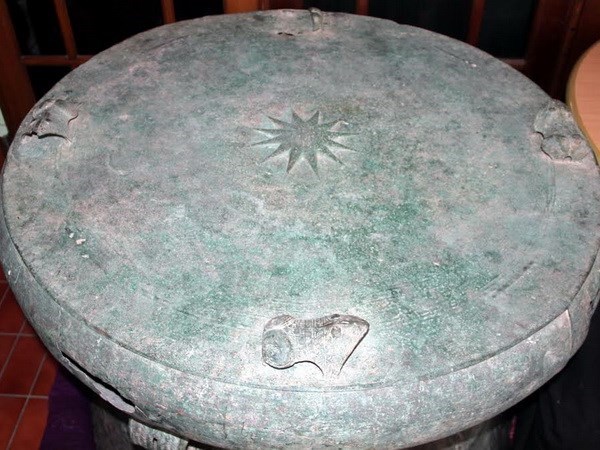
An exhibition of antiques representing the different civilisations of Vietnam will be held at the Hermitage Museum in St Petersburg from May 17 to September 22.
An exhibition of antiques representing the different civilisations of Vietnam will be held at the Hermitage Museum in St Petersburg from May 17 to September 22.
It is one of the activities to celebrate the friendship between Vietnam and Russia and marks the Russian Year in Vietnam and the Vietnamese Year in Russia.
 |
| The surface of a bronze drum belonging to the Dong Son Civilisation in the Red River Delta (Source: VNA) |
The exhibition also celebrates President Ho Chi Minh’s birthday (May 19).
With the theme Treasures of the Red River, the exhibition would include objects collected and stored at the Vietnam National Museum of History and the Hai Phong City Museum, according to curator Phan Tuan Dung.
Visitors will have a chance to understand different periods in the history of the Red River Delta, a region of the Indochinese Peninsula, with the art, traditions and way of life of Vietnamese people in the old days.
In ancient times, three cultures formed in today’s Vietnam: the Dong Son culture in the north, Sa Huynh in the centre, and Dong Nai in the south.
Dong Son (from 2500BC to first century AD) was found in the valleys of the Red, Ma and Ca rivers, and produced artefacts from stone, bronze, iron, clay, glass, wood and ivory.
“The most common are highly artistic cast bronze items that were characteristic of this culture: work tools, domestic utensils, weapons and musical instruments,” said Dung.
The most noteworthy artefact representing Dong Son are bronze drums bearing depictions of rituals and processions, humans and animals, as well as geometrical patterns, he said.
“The drums were used as musical instruments in rituals and to communicate. Dong Son drums were also symbols of power.”
At the same time as the Dong Son culture, in the central part of Vietnam the Sa Huynh culture (6000BC – second century AD) was developing.
Sa Huynh is known primarily for its funeral offerings, and remarkable objects including jewellery and ceramics have been found in tombs.
In the Mekong Delta, the Dong Nai culture (dating back 2,500 years) is known for its iron and pottery objects.
The Oc Eo culture arose in the south-western part of the Mekong Delta from the first to the sixth centuries. Along with traditional everyday artefacts, these sites yielded fired pottery, seals and coins.
Dung said this culture showed the exchange in culture and trade between Vietnam and regional countries such as China, Thailand and India. Among the finds made at the sites were Hindu and Buddhist sculptures in wood, stone and bronze.
Alongside the exhibits, the State Hermitage Publishing House has prepared a scholarly illustrated catalogue for the exhibition with forewords by Mikhail Borisovich Piotrovsky, general director of the State Hermitage Museum, and Nguyen Van Cuong, director of the Vietnam National Museum of History.
They will provide more stories of the history and culture of Vietnam.
Expert Dung said the event would boost mutual understanding and co-operation between the two countries in general and Vietnamese museums and the Hermitage in particular.
(Source:VNS/VNA)





